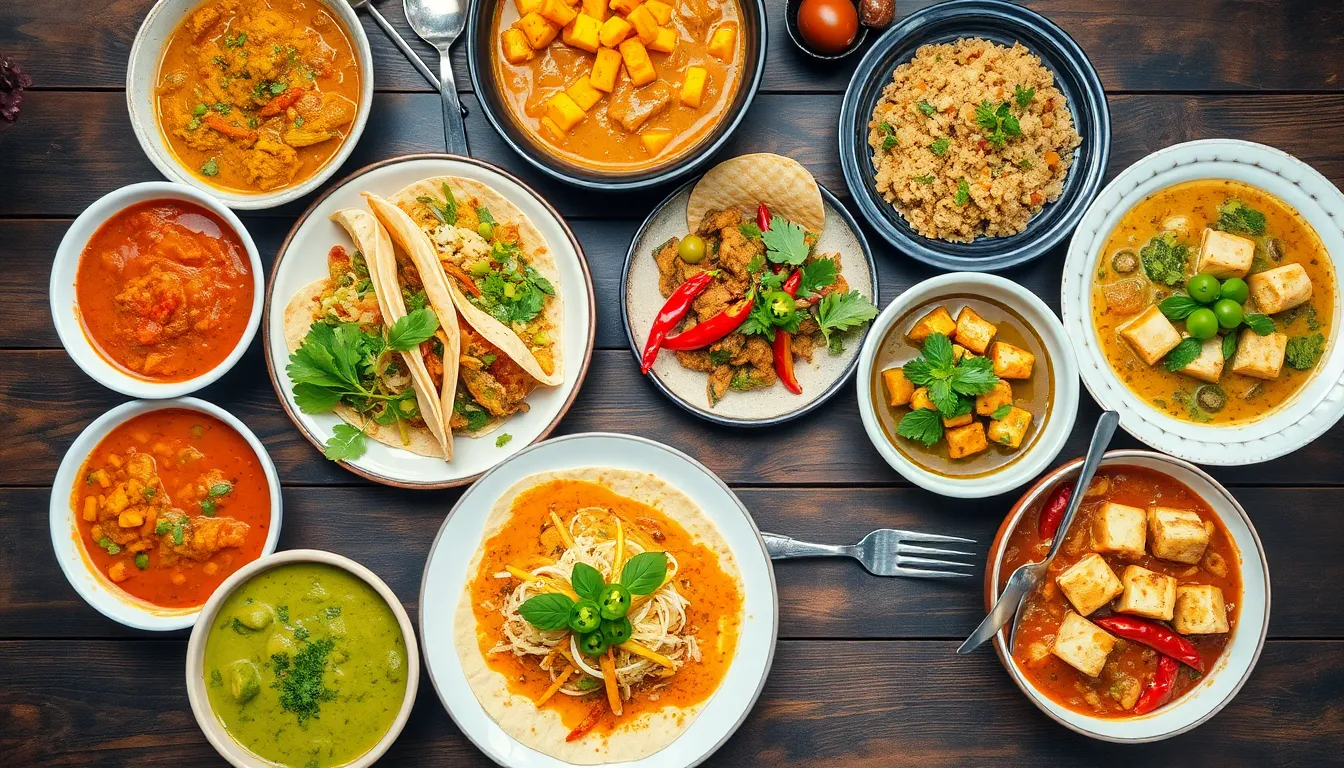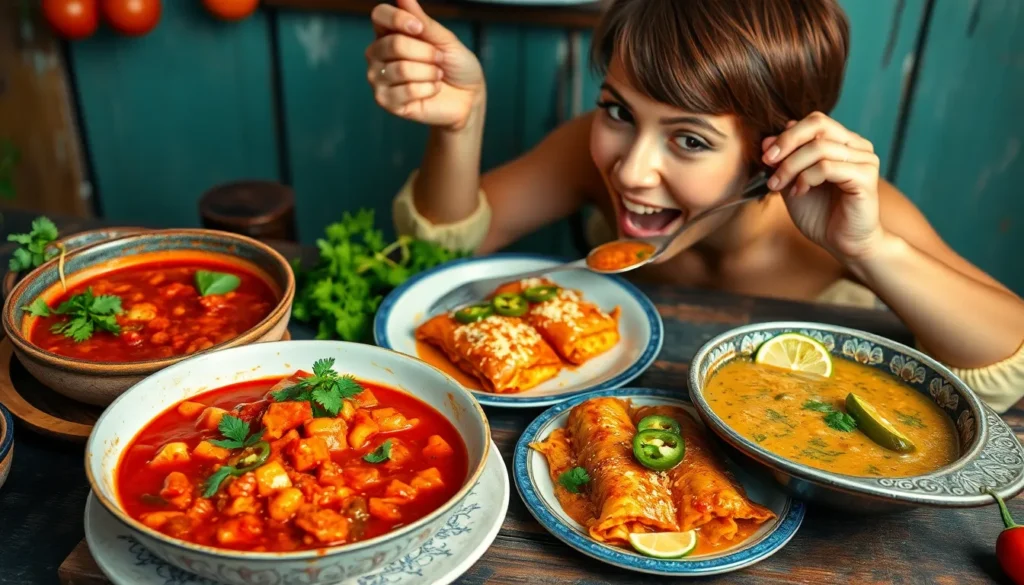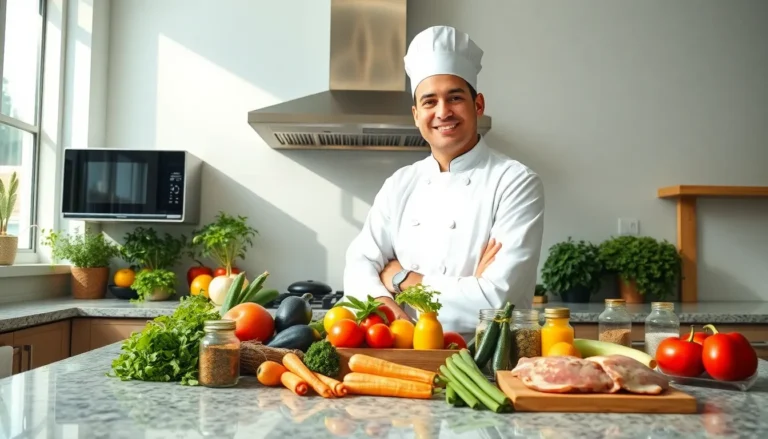Table of Contents
ToggleSpicy dishes have a magical way of igniting the taste buds and sparking joy in even the most mundane meals. Whether it’s a fiery curry that sets your mouth ablaze or a zesty salsa that dances on your palate, these dishes turn every bite into an adventure. Who wouldn’t want to feel like a culinary daredevil while enjoying a plate of something that could double as a personal challenge?
Overview of Spicy Dishes
Spicy dishes often showcase a diverse range of flavors and ingredients. Many cuisines around the world incorporate heat to create unforgettable taste experiences. Cultures such as Indian and Thai excel at crafting rich, complex curries filled with aromatic spices. Frequently, these dishes feature chili peppers, which lend heat while enhancing the meal’s overall flavor profile.
Varieties such as jalapeños and habaneros provide different levels of spiciness and unique tastes. Mexican cuisine celebrates this with dishes like spicy enchiladas and zesty salsas. In addition, spicy seafood offerings, such as Szechuan shrimp, highlight the effective use of chili oils and spices to elevate flavors.
Garnishes often accompany these meals, including fresh herbs and tangy lime, which balance the heat. Diners frequently seek out spicy dishes for the thrill of experiencing tingling sensations on the palate. Nutraceutical properties in spices like capsaicin also contribute potential health benefits, like metabolism boosts and pain relief.
Exploration of spicy dishes can lead to culinary adventures. For those who enjoy experimenting with heat levels, many chefs offer customizable spice options. Whether a subtle kick or an intense fiery explosion, the ever-growing variety of spicy dishes invites everyone to indulge in the excitement of bold flavors.
Popular Spicy Dishes Around the World

Spicy dishes around the globe showcase a vibrant array of flavors and heat profiles. Each culture offers unique interpretations that excite the palate.
Indian Cuisine
Indian cuisine is renowned for its rich and varied use of spices. Curries dominate the landscape, with dishes like vindaloo and madras packing notable heat. Chilies, turmeric, and cumin contribute to their depth of flavor. Tandoori chicken often gets marinated in spices that enhance its savory taste, while paneer tikka incorporates a delightful mix of spices for added zing. The diversity of Indian cuisine ensures a dish for every spice lover.
Mexican Cuisine
Mexican cuisine highlights bold flavors with its array of spicy ingredients. Dishes like enchiladas and tacos often feature jalapeños and habaneros for an extra kick. Salsas, crucial to the cuisine, mix fresh tomatoes, onions, and chilies, creating zesty accompaniments. Mole sauce, known for its intricate flavor profile, frequently contains chili peppers combined with ingredients like chocolate and nuts. These combinations make Mexican food a fiery yet unforgettable experience.
Thai Cuisine
Thai cuisine is famous for its balance of sweet, sour, salty, and spicy elements. Dishes such as pad Thai and green curry often contain fresh chilies, basil, and lemongrass for a vibrant taste. The combination of coconut milk and chili paste creates a creamy yet spicy sauce that enhances seafood and poultry. Street food, like som tam (green papaya salad), features shredded vegetables tossed with chilies, offering refreshing heat. Thai flavors truly deliver a compelling culinary journey.
Sichuan Cuisine
Sichuan cuisine stands out for its bold flavors and unique use of Sichuan peppercorns. Dishes such as mapo tofu and spicy hotpot highlight the intense heat created by dried chilies and garlic. The mouth-numbing quality of Sichuan peppercorns adds an intriguing dimension to the heat. Stir-fried dishes, like kung pao chicken, incorporate peanuts and chilies, resulting in a delightful blend of textures and flavors. This cuisine captivates those who seek an exciting culinary challenge.
Health Benefits of Spicy Dishes
Spicy dishes offer numerous health benefits that enhance overall well-being. Capsaicin, found in chili peppers, plays a significant role in this regard. This compound aids in boosting metabolism, helping the body burn calories more efficiently. Consumption of spicy foods often leads to increased energy expenditure, promoting weight management.
Additionally, spicy foods can improve heart health. Studies indicate that capsaicin may lower cholesterol levels and reduce blood pressure, contributing to a healthier cardiovascular system. Incorporating spicy ingredients into meals may, therefore, support long-term heart health.
Spices like turmeric, commonly found in Indian dishes, possess anti-inflammatory properties. They can help alleviate symptoms related to arthritis and other inflammatory conditions. Such benefits make spicy foods not only flavorful but also beneficial for managing chronic pain.
Furthermore, spicy dishes may enhance digestion. Peppers stimulate the digestive tract, increasing the production of digestive fluids. This stimulation can lead to improved digestion and absorption of nutrients.
Evolving research suggests that spicy foods may enhance mood. The release of endorphins, triggered by the heat from spices, contributes to a sense of well-being and happiness. Enjoying spicy meals could thus be linked to improved mental health.
Lastly, the vibrant flavors of spicy dishes can encourage healthier eating habits. People may opt for fresh vegetables, lean proteins, and whole grains when preparing spicy meals. This shift often leads to a more balanced diet overall.
Embracing the heat can bring joy and health benefits, making spicy dishes not just a culinary adventure but also a step toward better health.
Tips for Cooking Spicy Dishes
Control spice levels through proper ingredient selection. Fresh chili peppers bring heat, while dried flakes provide concentrated flavors. Consider using a mix of both to achieve a balanced heat profile.
Adjust cooking techniques to enhance spiciness. Roasting or grilling peppers intensifies their natural heat, making dishes more vibrant. Caramelizing onions can also add depth, counterbalancing the heat.
Incorporate dairy to tame fiery dishes. Ingredients like yogurt or sour cream soften the heat without sacrificing flavor. Adding these components at serving time allows diners to customize their heat experience.
Use acids to balance flavors effectively. Citrus juices and vinegars cut through the heat, adding brightness to dishes. A splash of lime juice in salsas or curries can elevate the overall taste.
Experiment with fresh herbs. Chopped cilantro, basil or mint can brighten spicy dishes, enhancing freshness and providing a contrast to the heat. These herbs deliver flavor without additional spice.
Maintain safety when handling chilies. Wear gloves to prevent skin irritation, and wash hands thoroughly after contact. Rinsing with cold water can alleviate any discomfort.
Prepare a spice blend ahead of time. Creating a signature blend offers convenience when cooking spicy dishes. Store the blend in an airtight container to preserve freshness and potency.
Pace the addition of spices during cooking. Start with a small amount, then taste and adjust accordingly. Layering spices throughout the cooking process builds complexity, allowing flavors to develop fully.
These tips not only enhance the culinary experience but also ensure that cooking spicy dishes remains enjoyable.
Spicy dishes offer a thrilling adventure for anyone willing to embrace bold flavors. They not only elevate meals but also provide numerous health benefits that enhance overall well-being. The diverse range of cuisines showcases the creativity and passion behind crafting these fiery delights.
As spice lovers continue to explore new culinary horizons, the joy of discovering unique combinations and techniques remains ever-present. With practical tips and an understanding of how to balance heat, everyone can find their perfect spice level. So whether it’s a fiery curry or a zesty salsa, the world of spicy dishes invites all to indulge in the excitement of flavor.








